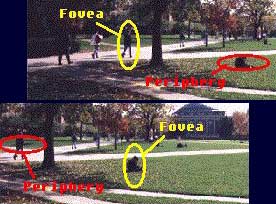
II.
Retinal Events, Perceptual Consequences,
and the Illusion of a Stable and Continuous World
Eye movements cause two very different types of retinal events.

First, the image of objects in the world change their retinal location from one fixation to the next. For example, an object may lie somewhere off the fovea in your peripheral vision, but after a saccade (a rapid eye movement), it will suddenly lie on the fovea, and what was on fovea has now moved off into your periphery of your retina. Usually, only objects imaged on the fovea are “seen” in enough detail to allow you to recognize what they are.
From the perspective of your eye, the world is continually jumping around, most of it is blurry and colorless, while only a small area is sharp, clear, and colorful. Bur our minds perceive the world as stable and colorful—a mystery we will explore in this module.